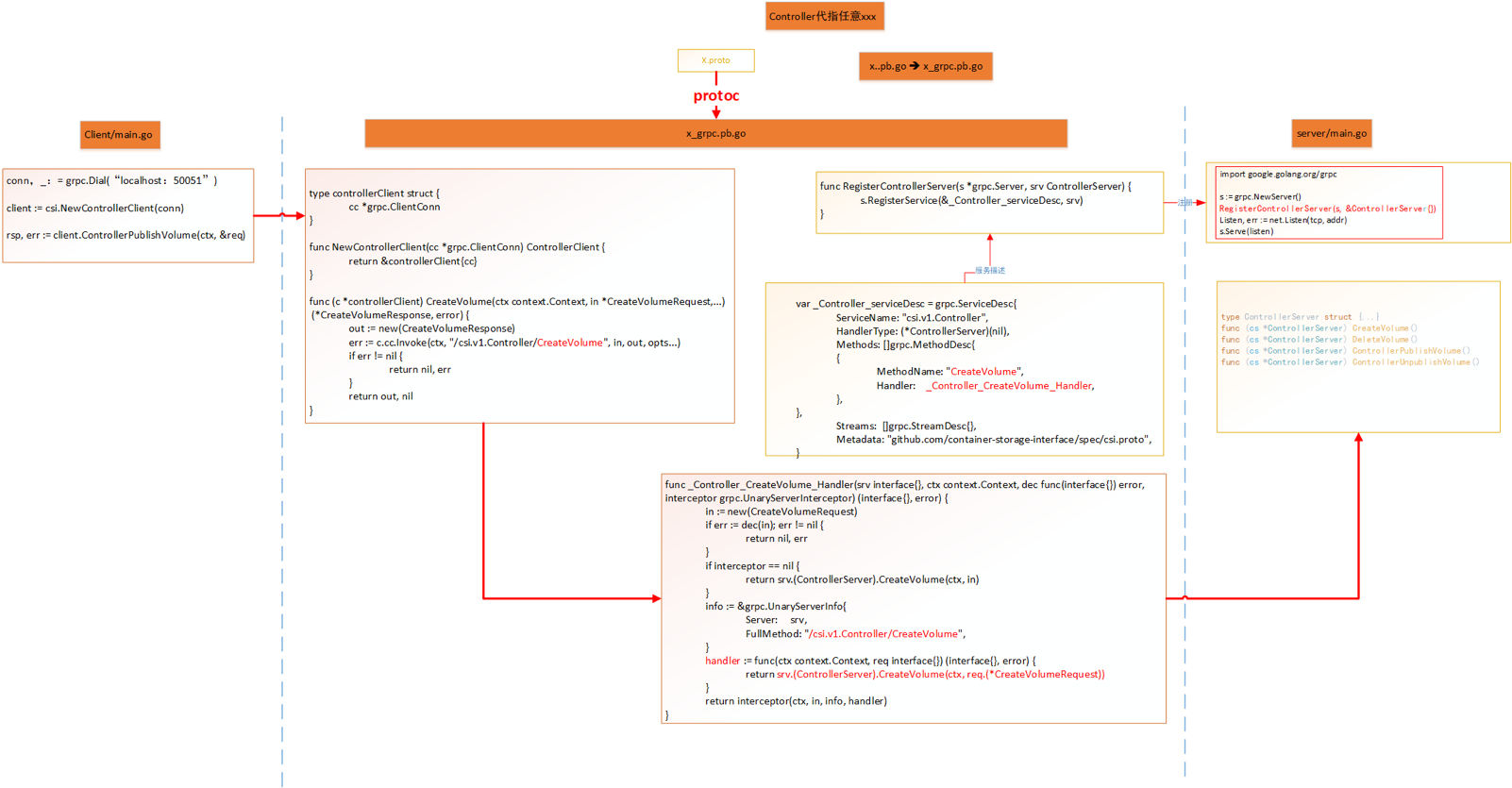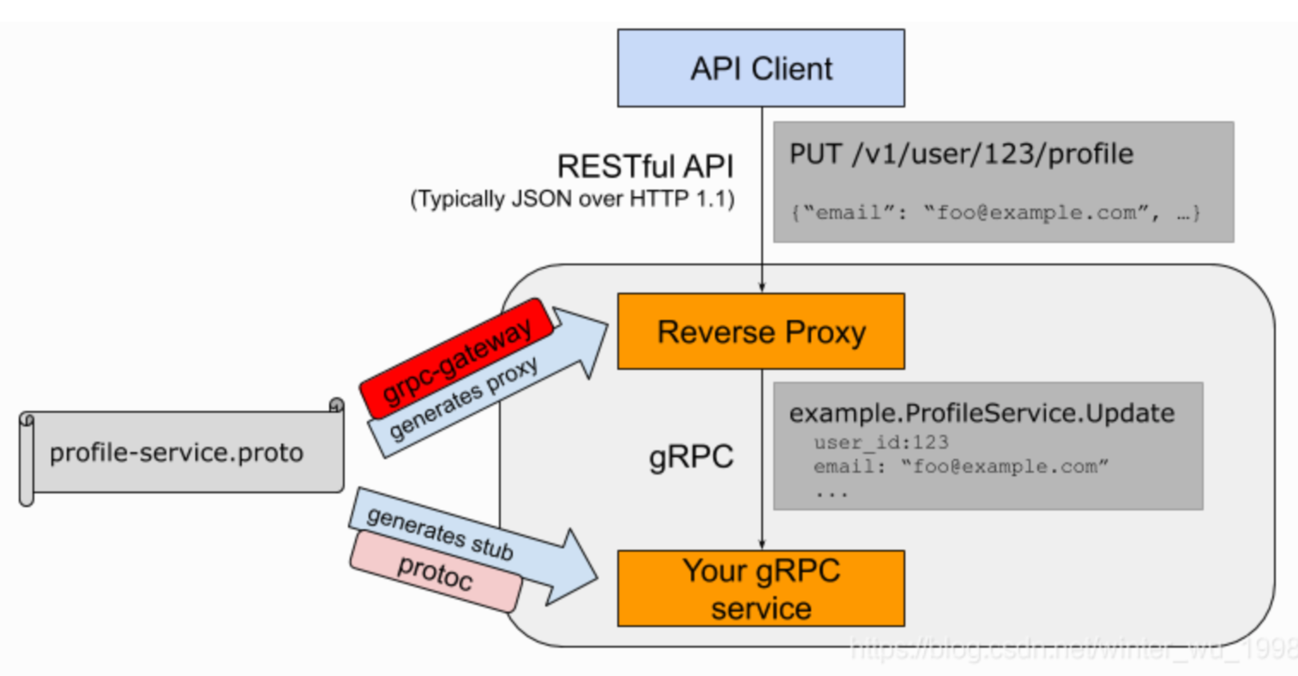相关代码: grpc-simple
rpc 简介
单体应用微服务化之后,之间会有调用需求,可以通过 http or rpc 方式完成
http 是和数据传输没关系的,数据传输是 tcp/ip 层做的, 而 http 负责定义好 client 与 server 交互数据的格式, 定义好后就可以有四层进行传输了。
RPC 则是远程过程调用,它不是一种协议,而是一种使用习惯/方式,所以和 HTTP 是两个维度的东西,RPC 也涉及到交互,需要约定好格式。它的实现可以基于http,也可以自定义格式,再由 tcp 四层传输,通常底层是http/2实现.
so why rpc?
用 http 是可行么? 答案时肯定的,考虑使用习惯和效率而选用 rpc
- 习惯:
RPC调用是因为服务的拆分,服务被拆分后非常期望代码上还和之前本地调用相同,因此需要RPC框架,来屏蔽这些底层调用细节 - 效率:
- http是通用规范,所以第三方库都使用
http作为通信协议。对于专用内部组件,完全可以改成自定义的rpc这种协议 - http的
json格式的数据是冗余,序列成二进制后许多重复的字段,浪费带宽,这其实是为了用户的可读性设计而rpc使用的是proto buf格式,放弃了可读性而追求效率。进行两个方面优化,Protobuf选用了VarInts对数字进行编码,解决了效率问题- 给每个字段指定一个整数编号,传输的时候只传字段编号,解决了冗余问题
- http是通用规范,所以第三方库都使用
csi 中的应用

csi的各个sidecar之间的调用都是通过grpc, 本次着重分析使用的接口文件.
csi中只使用了csi/csi.pb.go,而官方还会有另外一个csi_grpc.pb.go, 官方给出了这样的解释。
从1.30.x开始,protoc会生成两个单独的文件,将入参、出参、序列化代码存于pb.go,而grpc.pb.go存放接口
1 | From 1.30.x gRPC, gRPC protoc generates *.pb.go and *_grpc.pb.go separately: |
自己动手,丰衣足食
Prerequisites
- 安装Go
- protoc
- protocol compile
- protoc是用c++编写,用于编译.proto文件
- protoc-gen-go
- 安装Go plugins for protocol compiler
- 除了安装protoc之外,还需要安装各个语言对应的编译插件。
1
2
3
4
5
6
7
8
9
10
11
12
13
# PB_REL="https://github.com/protocolbuffers/protobuf/releases"
# curl -LO $PB_REL/download/v3.15.8/protoc-3.15.8-linux-x86_64.zip
# unzip protoc-3.15.8-linux-x86_64.zip -d $HOME/.local
# export PATH="$PATH:$HOME/.local/bin"
1. install
$ export GOPROXY=https://goproxy.cn,direct
$ go get google.golang.org/protobuf/cmd/protoc-gen-go@v1.26
$ go get google.golang.org/grpc/cmd/protoc-gen-go-grpc@v1.1
2.Update your PATH so that the protoc compiler can find the plugins:
$ export PATH="$PATH:$(go env GOPATH)/bin"protoc 中原生包含了部分语言(java、php、python、ruby等等)的编译插件,但是没有 Go 语言的,所以需要额外安装一个插件。https://github.com/protocolbuffers/protobuf/blob/master/src/google/protobuf/compiler/main.cc
Demo
创建.proto 文件
syntax = "proto3";
option go_package = "google.golang.org/grpc/examples/helloworld/helloworld";
package helloworld;
// The greeting service definition.
service Greeter {
// Sends a greeting
rpc SayHello (HelloRequest) returns (HelloReply) {}
}
// The request message containing the user's name.
message HelloRequest {
string name = 1;
}
// The response message containing the greetings
message HelloReply {
string message = 1;
}
编译proto
1 | # Syntax: protoc [OPTION] PROTO_FILES |
这里简单介绍编译参数:
- –proto_path或者-I:指定 import 的其他proto路径,可以指定多个参数,编译时按顺序查找,不指定时默认查找当前目录。
- .proto 文件中也可以引入其他 .proto 文件,这里主要用于指定被引入文件的位置。
- –go_out:golang编译支持,指定输出文件路径
其他语言则替换即可,比如 –java_out 等等 - –go_opt:可选参数,比如–go_opt=paths=source_relative就是表明生成文件输出使用相对路径。
- path/to/file.proto :被编译的 .proto 文件放在最后面
$ helloworld.proto
# protoc --go_out=. \
--go_opt=paths=source_relative \
--go-grpc_out=. \
--go-grpc_opt=paths=source_relative \
./helloworld.proto
编译后会生成两个文件。
helloworld.pb.go
helloworld_grpc.pb.go
编译过程可以分成两步
- protoc解析.protoc文件,编译成 protobuf 的原生数据结构保存在内存中;
- 调用特定的语言插件,渲染输出为特定语言的模板。
编写client和server侧
两侧的main.go,可以参考官方例子 helloworld
1 | # git clone -b v1.52.0 --depth 1 https://github.com/grpc/grpc-go |
grpc 高级特性
拦截器实现原理分析
拦截器分为服务端拦截器和客户端拦截器,所以一共有以下4种类型:
- grpc.UnaryServerInterceptor
- grpc.StreamServerInterceptor
- grpc.UnaryClientInterceptor
- grpc.StreamClientInterceptor
以 client 侧的拦截器为例进行分析
1 | # client |
多个形如 grpc.WithXXXInterceptor 方法作为函数入参,其实则是动态参数的DialOption对象, 语法糖。
with 传入的拦截器作为 Dial() 的参数,分析 Dial 呼叫的流程
func Dial(target string, opts ...DialOption) {
return DialContext(context.Background(), target, opts...) // 一个opts表示一个Withxxx参数,这里有多个,通过加三个点,告知下一层
}
func DialContext(ctx context.Context, target string, opts ...DialOption) (conn *ClientConn, err error) {
cc := &ClientConn{
...
dopts: defaultDialOptions(),
...
}
// opts 是with传入的可选拦截器
for _, opt := range opts {
opt.apply(&cc.dopts)
}
}
执行每一个 DialOption 对象的 apply() 方法,入参是 default dialoption 对象
主要流程结束,再返回头来分析 grpc.WithXXXInterceptor, 以 grpc.WithUnaryInterceptor(unaryInterceptor) 为例子。
// 闭包的用法
func WithUnaryInterceptor(f UnaryClientInterceptor) DialOption {
return newFuncDialOption(func(o *dialOptions) {
// 将拦截器方法 赋值给dialOptions的unaryInt field
o.unaryInt = f
})
}
func newFuncDialOption(f func(*dialOptions)) *funcDialOption {
return &funcDialOption{
f: f,
}
}
将外部拦截器 f,传入函数对象且作为入参。
这里直接返回匿名函数,内部是f(o)执行不就可以了吗?
实际是将匿名函数传入NewFuncXXX, 在newFuncXXX中,实例化funcDialOption对象,匿名函数作为其属性而已。
该类型对象及其方法。
1 | type funcDialOption struct { |
再回到执行处
1 | for _, opt := range opts { |
调用 funcDialOption 对象的 apply 方法。
实际是执行外部匿名函数
1 | func(o *dialOptions) { |
所以最后实现的功能是将拦截器方法赋值给 dialOptions 对象的 unaryInt field, 拦截器 f 是没有执行的。
拦截器何时执行呢?
1 | // call.go |
没有拦截器则直接执行invoke。
有拦截器,则由 UnaryInterceptor 拦截器去执行, invoke作为参数。
在 client 侧经常看到的c.cc.Invoke(ctx, "/helloworld.Hello/UnaryHello", in, out, opts...) 执行的就是该方法.
clientConn 对象就是 conn, err := grpc.Dial(address,...) 呼叫后返回conn链接对象.
UnaryInterceptor 拦截器的实现
1 | func unaryInterceptor(ctx context.Context, method string, req, reply interface{}, cc *grpc.ClientConn, invoker grpc.UnaryInvoker, opts ...grpc.CallOption) error { |
可以看到,最后执行的还是传入的 invoke 方法, 在 invoke 之前或之后可以定义一些逻辑,从而实现了 python 装饰器的功能,比如动态添加一些逻辑。
不管是普通rpc, 还是拦截器,最后调用的是invoke方法
1 | func invoke(ctx context.Context, method string, req, reply interface{}, cc *ClientConn, opts ...CallOption) error { |
依赖底层的clientStream对象,通过SendMsg, RecvMsg方法实现请求。
函数名作为变量的理解
- 入参是
UnaryClientInterceptor, 函数名表示一种类型,类似int. func(o *dialOptions)也是一种类型,等价于函数名,只是匿名而已,后面括号表示实例化,整体
表示一个函数实例化对象。个人认为没必要再封装一层1
2
3func(o *dialOptions) {
o.unaryInt = f
}funcDialOption
1 | func WithUnaryInterceptor(f UnaryClientInterceptor) DialOption { |
gRPC-Gateway
这种 protoc 插件使 rpc server 能对外提供 RESTful HTTP API 和 grpc service
安装插件
用于将protobuf内容生成http方法go get github.com/grpc-ecosystem/grpc-gateway/v2/protoc-gen-grpc-gateway
整体流程
大致就是以 .proto 文件为基础,编写插件对 protoc 进行扩展,编译出不同语言不同模块的源文件。
1)首先定义 .proto 文件;
2)然后由 protoc 将 .proto 文件编译成 protobuf 格式的数据;
3)将 2 中编译后的数据传递到各个插件,生成对应语言、对应模块的源代码。
Go Plugins用于生成.pb.go文件gRPC Plugins用于生成_grpc.pb.gogRPC-Gateway则是pb.gw.go, proxy功能的实现
原理图

client 发起 http req, 将七层的req类比ip层,req先到gateway, 由gateway转发请求到具体的grpc service.
。
为了让grpc service支持restful请求
1.修改 .proto 文件, 在原先 rpc 方法添加其他调用选项 option, 声明使用 google.api.http, methoh, url, body等参数, 形如
1 | service Hello { |
gRPC-Gateway 插件才能生成对应 http 方法
测试
运行server
1 | # go run main.go |
client通过grpc方式
1 | % go run main.go |
client通过http方式
1 | % curl -X POST -k http://0.0.0.0:8080/v1/UnaryHello -d '{"name": " world"}' |
grpc server同时提供 gPRC 服务和 HTTP 服务
原理分析
grpc server 仍然运行,因此 rpc 请求依然可以给予 service, 额外增加了一个http server, 由其向 rpc server 发起 rpc 请求, 具体方法是
runtime.NewServeMux()New了一个servermux,- 通过
pb.RegisterHelloHandler注册path为handler. - 将
servermux配置为http server的handler
1 | func RegisterHelloHandler(ctx context.Context, mux *runtime.ServeMux, conn *grpc.ClientConn) error { |
1 | # 路由path, 用于curl /v1/UnaryHello |
restful 请求先到http server, 由其 handler 通过 grpc client发起 rpc 请求
使用 context 进行超时控制
超时控制可以分成两种
- deadline: server侧执行超时,client被迫关闭。
- cancel: client发现错误主动关闭,不需要等server侧返回错误。
client 调用时传入
1 | // 1秒超时 |
只要 server 侧接口返回超过1s, client call 就返回 DeadlineExceeded error
第二种方式是不放在 defer 里,而是 client 直接调用 cancel()
小结:
- 类似
goroutine的ctx,context方式也适用于grpc, 其内部已经做了context的处理 ctx可以使用context.WithDeadline()或者context.WithTimeout(),二者效果类似,只是传递的参数不一样。 前者是在指定时刻超时,后者是过多久会超时。
grpc负载均衡(TODO)
grpc 服务发现
总结
- 编写
x.proto定义文件 - 安装特定语言的插件,生成
pb.go, gprc.pb.go, 使用的也是这两个文件,不包括x.proto, 这两个文件通常作为lib,托管在github上,里面定义好了client和server intrface.client已经实现好了,可以直接用,需要自己实现server. 三者名字关系一致,不受里面配置的影响。x.proto, x.pb.go, x_grpc.pb.go,
1 | type helloClient struct { |
实现
client/main.go, 主要步骤是grpc.Dial(addr),pb.NewClient,client.callMethod()实现
server/main.go,主要步骤是s:=grpc.NewServer(),pb.RegisterHelloServer(s, &Hello{})注册服务Hello对象实现grpc接口,net.Listen(),rpcserver.Serve(listen)根据
x.proto中定义,可以确定请求路径是·/${包名}.${服务名}/${接口名}